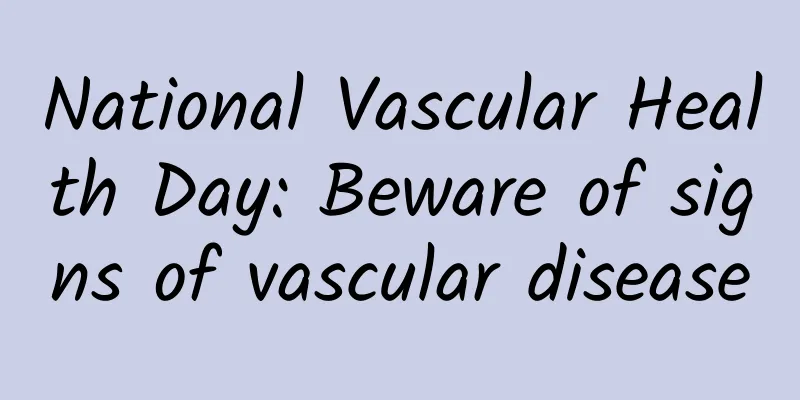National Vascular Health Day: Beware of signs of vascular disease

|
May 18 this year is the 12th "National Vascular Health Day". Blood vessels are important "pipelines" for transporting oxygen, nutrients and metabolites. Once problems occur in them, they will lead to a variety of diseases. The number 5.18 comes from an indicator value: 5.18 mmol/L, which is the critical value of abnormal total cholesterol in normal people's blood. It aims to call on people to protect vascular health, be vigilant about vascular plaques, keep blood vessels young, and thus reduce the incidence and mortality of cardiovascular diseases such as myocardial infarction, sudden death, stroke, and cerebral infarction. Good and bad blood vessels: What do “good blood vessels” look like? The human body is full of blood vessels, except nails, hair, epithelium, cornea, etc., which are divided into veins, arteries and capillaries according to their structure and function. Good blood vessels often have three golden standards: smooth, elastic and slippery. Smooth: Arteries can transport blood smoothly to the whole body, and blood vessels are unobstructed, which can supply nutrients to the whole body. Even when you are older, your blood vessels are unobstructed and blood flows fast, which reduces the risk of cardiovascular and cerebrovascular diseases. Elasticity: As we age, our blood vessels will gradually become harder and more brittle, and even lose their elasticity, especially chronic non-communicable diseases that affect the elasticity of blood vessels, referred to as chronic diseases (NCDS), including hypertension, hyperlipidemia, diabetes, coronary heart disease, stroke, etc. We must actively control our condition. Smooth: Good blood vessels are like newly bought "water pipes". The inside of the pipe is smooth and unobstructed, and no other "impurities" can be seen. There are no accumulated metabolic products and garbage, that is, atherosclerotic plaques. Only good blood vessels can be found. Note: The picture is from the Internet What do “diseased blood vessels” look like? When blood vessels age, become hard and brittle, the formation of plaques can cause the diameter of the blood vessels to become smaller, leading to vascular stenosis and blockage. Warning signs of vascular disease: 1. Sudden chest tightness If you suddenly feel chest tightness, shortness of breath, or even faint when you stand up after sitting for a long time or lying in bed, you should be alert to the possibility that a blood clot in the vein of the lower limbs has detached and blocked the pulmonary artery, leading to pulmonary embolism. Cerebral artery embolism is very harmful and can cause sudden death in severe cases. If you experience the above symptoms, you should seek medical attention as soon as possible. 2. Chest pain The coronary artery is a blood vessel that supplies blood to the heart. If it is blocked or narrowed, the blood supply to the heart will be restricted, and severe ischemia will cause chest pain. If the chest pain is persistent, it is more dangerous, which means that the coronary artery is completely blocked and the blood flow is completely interrupted. If it lasts for more than 15 to 20 minutes, the myocardium will be necrotic, that is, myocardial infarction. 3. Limb weakness Sudden weakness in the limbs (including upper and lower limbs) indicates blockage of the cerebral artery or carotid artery. It may also be accompanied by slurred speech, facial paralysis on one side, blurred vision, etc. 4. Edema and changes in urine volume The renal artery is responsible for the blood supply to the kidneys. If plaques occur in the renal artery, it may reduce the blood supply to the renal artery and even affect kidney function, causing symptoms such as fatigue, decreased appetite, changes in urine volume, and limb edema. 5. Intermittent claudication The arteries of the limbs are responsible for the blood supply to the upper and lower limbs. When the blood vessels in the lower limbs are ischemic, leg pain may occur when walking, which may be relieved after resting, but will reappear when walking again. This is medically known as "intermittent claudication." Prevention of blood vessel blockage: Adjust your lifestyle: Mainly eat a light, low-salt, and low-fat diet, and ensure the supply of protein, dietary fiber, multiple vitamins, and minerals. Keep exercising, 4 to 6 times a week, more than 30 minutes each time. Brisk walking, cycling, swimming, push-ups, and dumbbell lifting are all good forms of exercise. Cooperate with doctors for diagnosis and treatment: In addition to adjusting daily living habits, people with different conditions should follow the doctor's advice and use drugs such as lowering blood lipids and preventing thrombosis. Stabilize the "atherosclerotic plaques" on the blood vessels through drug treatment to avoid plaque shedding, thrombosis, and blood vessel blockage to the greatest extent. Do not listen to folk rumors. Actively participate in physical examinations: Usually, hospital examinations can better detect vascular sclerosis. For example, chest X-rays show tortuosity and widening of the aorta, accompanied by local calcification; color Doppler ultrasound of the neck vessels shows irregular and obvious thickening of the intima-media of the carotid artery, strong echo plaques, and inhomogeneous echoes; enhanced CT angiography of the vessels shows contrast agent filling defects and stenosis of the lumen in the abdominal aorta, external iliac artery, and superficial femoral artery. Choose genetic testing: The etiology of cardiovascular disease is related to heredity. For example, about 60% of adult patients with hypertrophic cardiomyopathy (HCM) can detect clear pathogenic gene mutations. There are many other cardiovascular diseases that are mainly caused by genetic mutations, including familial hypercholesterolemia, which manifests as premature coronary atherosclerosis, hereditary thrombophilia, which manifests as deep vein thrombosis, and hereditary arrhythmias, which manifest as problems with the cardiac conduction system. Hereditary aortic disease, including Marfan syndrome and familial thoracic aortic aneurysm dissection, simple pulmonary hypertension, and hereditary hypertension that occurs in young people or is difficult to control with drugs also have relatively clear genetic causes. To learn more about cardiovascular health, please follow Dr. Ma’s Heart Lectures Original article, no reproduction without authorization |
>>: IDC: Global smartphone shipments are expected to grow 4% in 2024
Recommend
Please remember these four lines of defense to prevent myocardial infarction! Compare and see how many of them you have achieved?
Not long ago, a young man suddenly suffered chest...
Can cervical erosion and hypertrophy heal itself?
In fact, women generally do not need special trea...
Why does the money grass bloom so often? What fertilizer is best for the copper coin grass?
The names of money grass and copper coin grass ar...
Can coriander roots be eaten? How to keep coriander fresh for a long time
The tender stems and fresh leaves of coriander ha...
Korea Statistics Office: As of October 2021, the number of food delivery workers in South Korea has risen to 428,000, a year-on-year increase of 9.7%
Data released by the Korea National Statistical O...
Pregnancy due to blockage of both fallopian tubes
Bilateral fallopian tube obstruction is a common ...
[Anatomist who knows sports] How dare you exercise without stretching?
How dare you exercise without stretching? The dou...
Is cervicitis contagious in women?
Cervicitis is a relatively common gynecological d...
Red and painful pimples on chin
Women will have a few days of irritability every ...
Is it normal for women to have lumps in their breasts?
A woman's breasts are the part she should be ...
Why does postpartum urethral bleeding occur?
If a female friend has urethral bleeding after gi...
The sweeter the fruit, the more sugar it contains! Some fruits are not sweet, but they are full of sugar!
In? Have you kept your sugar intake under control...
Causes of buttock pain in late pregnancy and precautions in late pregnancy
Pregnant women will experience many different sym...
Which parts of women must remove hair
Introduction: People say that garbage is a "...
How many weeks of pregnancy does the fetal heartbeat and fetal bud appear?
Under normal circumstances, the fetal bud and ini...









